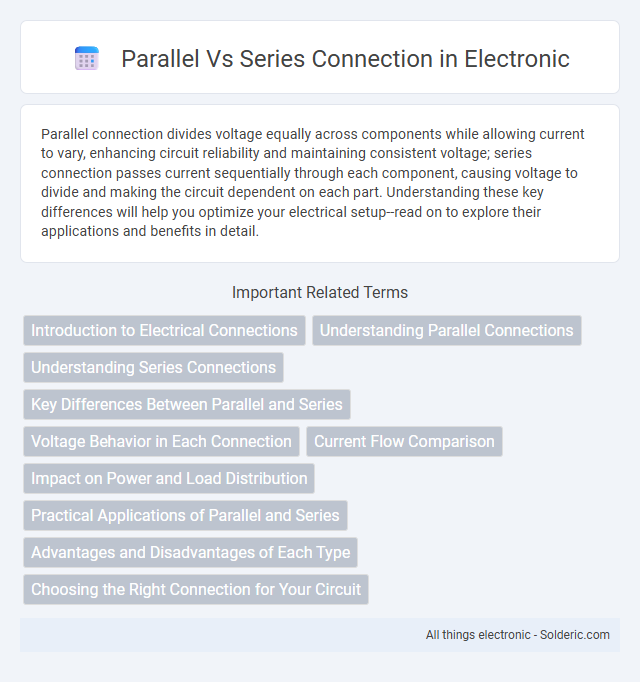Parallel connection divides voltage equally across components while allowing current to vary, enhancing circuit reliability and maintaining consistent voltage; series connection passes current sequentially through each component, causing voltage to divide and making the circuit dependent on each part. Understanding these key differences will help you optimize your electrical setup--read on to explore their applications and benefits in detail.
Comparison Table
| Feature | Series Connection | Parallel Connection |
|---|---|---|
| Voltage | Sum of individual voltages | Same as individual voltage |
| Current | Same through all components | Sum of individual branch currents |
| Total Resistance | Sum of resistances (R_total = R1 + R2 + ...) | Reciprocal sum (1/R_total = 1/R1 + 1/R2 + ...) |
| Failure Impact | One failure breaks circuit | Other branches continue working |
| Use Cases | Simple circuits, voltage addition | Power distribution, consistent voltage |
Introduction to Electrical Connections
Electrical connections are fundamental in determining how current and voltage behave in a circuit, with parallel and series being the two primary types. In a series connection, components are linked end-to-end, so the same current flows through each element while the voltage divides across them. A parallel connection splits the current among branches, maintaining the same voltage across each component, optimizing your circuit's performance based on the desired electrical behavior.
Understanding Parallel Connections
Parallel connections distribute electrical current evenly across multiple components, ensuring each receives the full voltage of the power source. This configuration enhances circuit reliability; if one component fails, current continues to flow through the other pathways. Understanding parallel connections helps you design systems with consistent voltage and increased fault tolerance for your electrical projects.
Understanding Series Connections
In a series connection, electrical components are linked end-to-end so that current flows through each component sequentially, making the total resistance equal to the sum of all individual resistances. Voltage divides across the components, meaning that the sum of voltage drops equals the source voltage, which affects how devices like batteries or light bulbs operate in your circuits. Understanding series connections is crucial for designing circuits where consistent current flow is needed, but one failure interrupts the entire circuit.
Key Differences Between Parallel and Series
Parallel circuits have multiple paths for current flow, allowing components to operate independently, while series circuits have a single path where current flows sequentially through all components. Voltage remains the same across each component in a parallel connection, whereas in series circuits, voltage divides among components proportionally to their resistance. Parallel connections provide higher reliability and consistent voltage, while series connections offer straightforward design but are sensitive to component failure, as one break interrupts the entire circuit.
Voltage Behavior in Each Connection
In series connection, the voltage across each component divides proportionally to its resistance, with the total voltage being the sum of individual voltages. In parallel connection, each component receives the full source voltage, meaning voltage remains constant across all branches. Understanding these voltage behaviors helps you design circuits to achieve desired electrical performance.
Current Flow Comparison
In parallel connections, current divides across multiple paths, with each component receiving the full voltage and the total current equaling the sum of individual branch currents, following Kirchhoff's Current Law. Series connections have a single path for current flow, causing the same current to pass sequentially through all components, while voltage drops cumulatively across each element. The distinct current behavior in parallel circuits makes them ideal for systems requiring consistent voltage, whereas series circuits are suited for applications where current uniformity is essential.
Impact on Power and Load Distribution
In parallel connections, power is distributed evenly across multiple components, allowing each load to operate independently and maintain consistent voltage while sharing the total current. Series connections result in the same current flowing through all components but cause voltage to divide proportionally, potentially reducing the power delivered to each load based on their resistance. Understanding these differences helps you optimize your circuit design for desired power efficiency and load balancing.
Practical Applications of Parallel and Series
Parallel connections are widely used in household electrical wiring to ensure consistent voltage across all devices, allowing independent operation of lights and appliances. Series connections are common in low-voltage applications like Christmas lights and simple circuit designs where current consistency is crucial. Understanding these practical applications helps optimize circuit performance and safety in various electronic and electrical systems.
Advantages and Disadvantages of Each Type
Parallel connections offer the advantage of maintaining consistent voltage across all components, ensuring that if one device fails, others continue to operate independently, although they require more wiring and can increase overall current demand. Series connections provide simplicity in wiring and ensure the same current flows through all components, but a failure in one element interrupts the entire circuit and voltage divides among components, potentially causing uneven performance. Choosing between parallel and series depends on the specific application needs, such as reliability versus simplicity and consistent voltage versus current control.
Choosing the Right Connection for Your Circuit
Selecting the appropriate connection type for your circuit depends on the desired voltage and current characteristics; series connections increase total voltage while maintaining the same current, making them ideal for devices requiring higher voltage. Parallel connections keep voltage constant across all components but increase the available current, suitable for circuits needing stable voltage with higher current capacity. Understanding the power requirements and behavior of your circuit components helps you choose the right connection to optimize performance and safety.
Parallel vs Series connection Infographic

 solderic.com
solderic.com